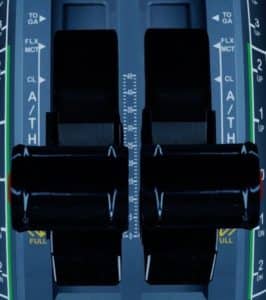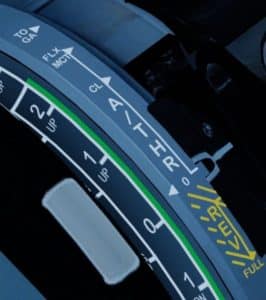From the A320 series onwards, the throttle and power setting system on Airbus aircraft is designed to maximize efficiency, safety, and fuel economy. This is achieved via an intricate computer-based management autothrust system (A/THR) integrated in line with the Airbus Fly By Wire (FBW) system.
Airbus Autothrust (A/THR) System
As part of this systems architecture, a system known as thrust detents is used on the A/THR system. The 4 detents found on Airbus throttle systems are as follows:
- Idle – When the Idle detent is selected, the fuel flow setting to engines is at idle power.
- CL (Climb) – Climb detent is selected for automatic management of engine thrust settings for most phases of flight. CL is selected upon the aircraft reaching predetermined Thrust Reduction Height (TRH) as set via the Multi-Purpose Control Display Unit (MCDU) prior to departure. TRH can be calculated by adding Airport Elevation + pre-determined deceleration altitude. In most departure configurations, this will be 1500 feet. Assuming this typical setting, TRH = Airport Elevation + 1500 feet.
- FLX MCT – Selected for derated takeoffs, FLX MCT sets the engine thrust as selected via the Flex Temperature (FLX TMP) setting on the MCDU.
- TOGA – short for Takeoff Go-Around, the TOGA detent setting provides the maximum engine thrust setting. This setting is selected for go-arounds and takeoffs which require full engine thrust.
Excluding idle detent, these thrust settings will activate the Autothrust (A/THR) system. The A/THR system can be verified as engaged by the green light on the center of the Flight Control Unit (FCU) panel.


As can be seen in the above images, thrust detent settings are outlined by white markers that correspond with the position of the thrust levers. This provides a clear visual guide to the flight crew as to the selected detent setting. This visual reference is accompanied by a distinctive “click” noise when a detent is selected.
Further verification of detent selection can be found on the upper portions of the Primary Flight Display (PFD). The detent setting is included under the Flight Mode Annunciator (FMA) section.
If the aircraft is outside of the safe flight envelope, the Fly By Wire (FBW) system will override any selected detent settings.
In this instance, Alpha Floor Protection (ALPHA PROT) mode will be engaged automatically via the FBW system. This setting accompanies TOGA LK (TOGA Thurst Locked) power settings in which TOGA thrust is selected.
In order to disengage TOGA LK, the flight crew must disengage A/THR via pressing the 2 red buttons found on the side of the thrust levels simultaneously. Further verification of the system’s status can be checked via the A/THR section of the FCU panel and on the FMA.
The above description has not accounted for the Reverse Thrust portion of the Airbus detent system, which can be activated by moving thrust levels into the section marked in yellow below the IDLE detent. This is accompanied by moving the reverse thrust levers found on top of the throttles into a backward position.
The exact reverse thrust setting selected can be adjusted accordingly.
Differences to Boeing Autothrottle System
In comparison to Boeing’s autothrottle system, the Airbus approach to thrust management differs greatly. On Boeing aircraft, thrust levers are controlled mechanically via servos. They are dynamic in that they adjust in accordance with the required thrust settings.
On the Airbus Autothrust (A/THR) system, the throttle positions are static in that power settings are adjusted without the physical maneuvering of thrust levers from their selected detent setting.
The lack of tactile indications and feedback from Airbus thrust levers means flight crew rely on monitoring engine thrust settings via the upper ECAM, in which N1, N2, EPR, and EGT parameters are displayed.
From a maintenance perspective, the lack of a requirement for throttle servos reduces costs to some extent.
However, the lack of mechanical indication or positioning of the thrust levers on Airbus aircraft can be disorienting in some regards when transitioning from automatic thrust management to manual thrust control.
In most Airbus operators’ SOPs, auto thrust and pertinent detent settings are utilized throughout all phases of flight. The Pilot Flying (PF) will select IDLE mode upon the RETARD callout issued. The RETARD callout refers to the aural command informing the pilot that engine thrust levers should be selected to IDLE prior to touchdown.
The RETARD callout is sounded at 10 feet Above Ground Level (AGL) or above touchdown.
Autothrust Settings on the MCDU
On the MCDU, FLX TEMP (derated takeoff thrust) and Thrust Reduction Height (TRH) are selected on the takeoff page of the Performance (PERF) section.
Upon reaching TRH, the FMA located on the PFDs will provide visual instruction to the flight crew to select the CL (Climb) detent.
In CL mode, the A/THR system will regulate thrust settings in accordance with the target speed setting. The target speed can be maintained by the A/THR in either Managed or Selected speed mode. Selected mode can be activated by entering target speed on the FCU followed by pulling the speed knob outwards.
Managed mode can be activated by pushing the speed knob inwards, in which a solid amber dot accompanied by dashes through the speed window of the FCU. In managed mode, the target speed is sourced via the speed settings provided on the flight plan entered via the MCDU.
Read More:
Airbus Engine Mode Selector Crank
This is an updated article. Originally posted on January 13, 2022 @ 3:07 pm

After visiting more than 60 countries, I have probably been on every type of plane there is and visited countless airports. I did my very first international solo trip to South Africa at the age of only 16 and haven’t really stopped traveling since.
Despite the adventurous travel itch, I do have a nerdy side as well – which is satisfied by writing about all things aviation “too boring” for my regular travel blog.